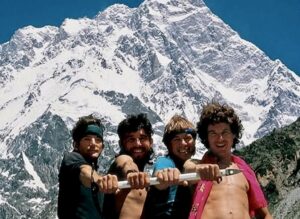The Moche civilization lived in northern Peru from 100 AD to 700 AD. These pre-Columbian people were famous for their pottery, metalwork, and farming skills. Their society thrived for centuries. But eventually, their culture collapsed. What happened?
Although we know a surprising amount about the Moche, scholars continue to debate whether theirs was a city-state or an empire. They organized themselves into separate administrative districts but shared a culture. The two main regions were the Northern and Southern Moche. Southern Moche, the cultural capital, had a population of over 25,000. It included the famous adobe Huacas del Sol and de la Luna heritage sites. Northern Moche consisted of deep valley networks whose access to water were important during the Moche’s decline.
Master artisans and farmers
The Moche’s murals and pottery were particularly unusual. They focused on themes like death and sexuality. Their pottery often depicted the loss of bodily fluids — pee, snot, blood — and explicit sexual scenes with the opposite or same sex.
Their art also depicted sexual slavery, ritual sacrifice, warfare, and vivid portraits. These figures probably symbolized elements of their religion, including transformation, life cycles, and fertility.

Huaca Rajada and the Royal Tombs of the Lord of Sipan. An archaeological site near Chiclayo, Peru. Photo: Barbara Ash/Shutterstock
However, their use of electroplating really set them apart from their Peruvian counterparts at the time. They were one of the very few ancient people to use this practice. Electroplating did not become common on an industrial scale until the 19th century, yet the Moche’s simple techniques exquisitely plated copper and other metals in thin layers of silver and gold.
The Moche also built networks of irrigation canals to tame the desert across its many districts. This helped unite them and keep the peace.

Details of Huaca de la Luna, an ancient pre-Incan pyramid in Trujillo, Peru. Photo: Jess Kraft/Shutterstock
Collapse
Historians estimate that 500-700 AD marked the decline of the Moche. Archaeologists found odd discrepancies from this period, including uncharacteristic changes in religious practices and art, the sudden appearance of military forts, an increase in weapons, and the concentration of settlements in the valleys. These indicate a period of heightened warfare or tension, as well as environmental disasters.
Theories
A combination of factors caused the Moche culture to wither. First, historians believe that an intense El Niño event caused weather disasters throughout their society. The beginning of their decline coincided with the Volcanic Winter of 536 AD, which cooled temperatures around the globe. This abrupt climate change created several decades of increased rain, followed by deadly drought. These undoubtedly led to crop failure, flooding, destruction of towns, disease, crop failure, contaminated supplies, and civil unrest. The tectonic activity also increased during this time.

The ancient pyramid known as the Huaca del Sol in Trujillo, Peru. Photo: Jess Kraft/Shutterstock
Archaeological evidence of a body used in human sacrifice found evidence that confirmed an intense flood. During droughts, the Moche likely moved to those valleys containing leftover deposits of water. These emergencies sparked increased conflict for those rare resources, as well as general social instability.
Evidence suggests that the shaken culture may have abandoned some of its traditional practices as a response. For example, they adopted foreign cultural elements in funerary rites and tombs. Possibly, the Moche found themselves disillusioned from the catastrophe and turned to foreign gods.
War?
The militaristic and expansionist Wari may have wiped out the Moche. The Wari State seemingly rose to power as the Moche declined. They might have taken over territory, resources, and trade networks. The Wari survived until 1100 AD. While conflicts between various peoples in the region were normal at the time, the importance of the Wari in the Moche’s demise remains unconfirmed.
The Moche did not disappear completely. Geologist Fred Andrus with the University of Alabama says that the Moche might have simply adapted. This means evolving into a different culture. Historians determine that the Moche transformed into the Chimú, a group with vastly different art forms and religious beliefs.
The takeaway
The Moche had a rich history which unfortunately ended when the world was at its worst. The 6th century was one of the worst times to be alive, not just for the Moche, but for many civilizations around the world.
Apart from the environmental disasters, warfare, and disintegration of their culture, the Moche vanished because of a lack of unification. According to Ryan Williams of the Field Museum in Chicago, each kingdom had separate “trajectories”. Simply put, the Moche disbanded after experiencing hard times and literally started over elsewhere.
Their struggle was not in vain. The Chimú — the culture they became — carried on for over 500 years before the Inca conquered them. They had one of the largest kingdoms in Peru up until 1470.






